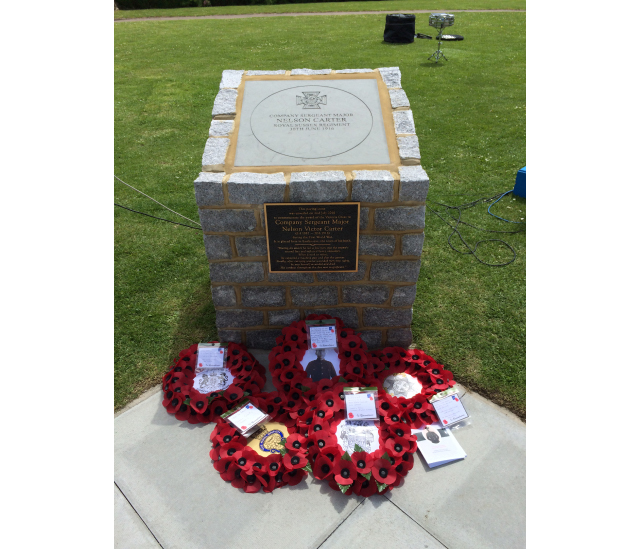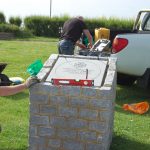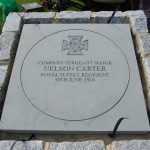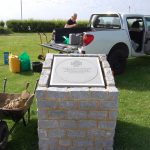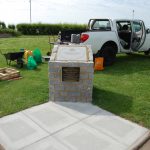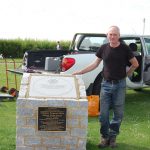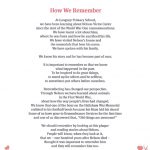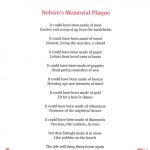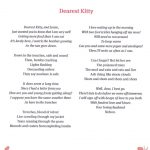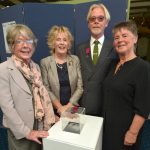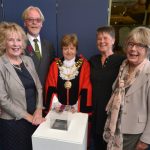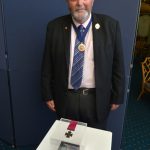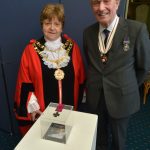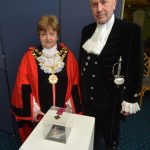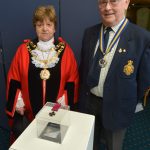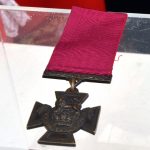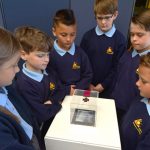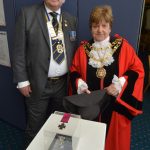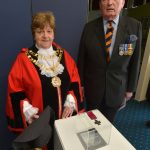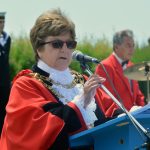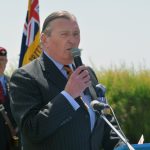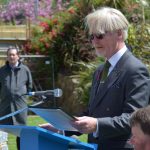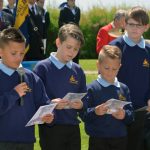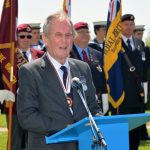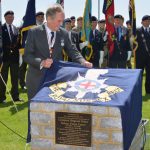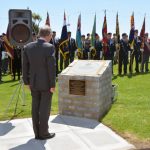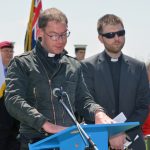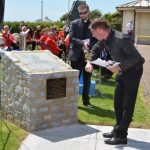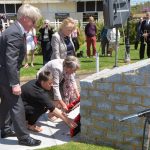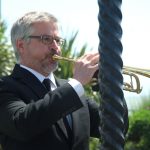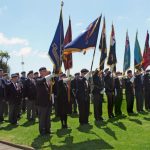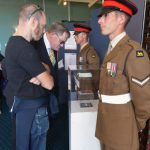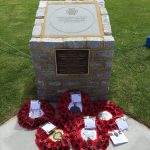On 30 June 1916, whilst rescuing wounded soldiers from No Man’s Land, Nelson Victor Carter was killed in action during the Battle of the Boar’s Head. For his bravery he was subsequently awarded the Victoria Cross. On 2 July 2016, a memorial for Nelson was unveiled in Eastbourne. This is the story of how we did it.
In August 2013, the Department for Communities and Local Government announced a competition for a memorial paving stone design to commemorate British recipients of the Victoria Cross during the First World War in their home towns. The winner was subsequently selected in November 2013, and plans were put in place for each town and county to begin receiving the memorial stones to place in whatever location and manner they saw fit.
Having been born in Eastbourne and lived there at various points in his life it was decided that Nelson Carter’s memorial paving stone should go to that town. East Sussex had already unveiled memorial paving stones to two other VC recipients in 2014; Sidney Woodroffe and Cuthbert Bromley. Nelson would be the third.
Planning
In August 2015, Eastbourne Borough Council and East Sussex County Council began the preliminary planning process for Nelson Carter’s stone and ceremony. It was important during the early planning process to consider a variety of key questions:
- What would be the location of the memorial?
- What would be its design?
- When would the unveiling take place?
To answer these initial questions regular meetings began between Peter Finnis (Senior Head of Corporate Development and Governance) and Nicola Metcalfe (Personal Assistant, Corporate Development and Governance) of Eastbourne Borough Council, and Lee Banner (Policy Officer), Beth McGhee (Policy Development Intern), and Chris Kempshall (Project Officer for First World War Centenary Commemorations) of East Sussex County Council.
Location
With the two previous paving stone memorials in East Sussex it had been important to find a location that was both fitting and suitable, and that would also allow members of the public to see it. Most towns across East Sussex have a main war memorial commemorating those killed in the two World Wars. However, because of their role as a focal point for the community in the years immediately after the First World War they are often located at key road junctions without much additional space around them.
In order for the paving stone memorial to be frequented by the public, and also to allow for a full unveiling event, it was decided that more space would be needed than the Eastbourne War Memorial could offer. Fortunately there was a fitting alternative.
Eastbourne Redoubt has a long tradition of showcasing the town’s military history. Both the fortress itself and the connected Pavilion Tearoom and gardens offer a substantial amount of space as well as an unobstructed view out over the shore to the sea. Moreover, Nelson Carter’s daughter had bequeathed his Victoria Cross to her four children. In time they then passed it on to the Royal Sussex Regimental Collection, which is held in the Redoubt museum in 2001. All of this made the gardens outside the Pavilion a desirable option.
After consulting with Spyke Baker, Nelson Carter’s grandson, this location was deemed fitting for the placement of the memorial.
Design
By the very nature of its design the paving stone memorials can either be laid directly in the ground or, alternatively, displayed upon a plinth or pillar. During the planning for Sidney Woodroffe’s memorial outside Lewes library it was decided that a plinth had the benefits of turning the memorial into a focal point and also removing the possibility that people could unwittingly walk upon the paving stone.
The gardens outside the Pavilion tearoom already host a memorial, on a plinth, to the men of the 9th Battalion, Royal Sussex Regiment who fought at the Battle of Pinwe in the Second World War. We identified that the addition of a plinth to hold Nelson Carter’s memorial stone would tie in with the existing memorial in the garden and also make it easily identifiable to passersby.
Alongside the plinth it was also decided that the memorial would consist of an explanatory plaque which would recite the citation details for Nelson Carter’s Victoria Cross from the London Gazette. This plaque would also give key details as to the nature of the memorial and its date of unveiling.
The job of organising the construction of the plinth and the sourcing of an explanatory plaque was given to Gareth Williams, Senior Specialist Advisor, Eastbourne Borough Council.
On 28 June, the memorial paving stone for Nelson Carter was installed on the plinth alongside the explanatory plaque, ready for unveiling.
- The installation of Nelson Carter’s Memorial Paving Stone
- The installation of Nelson Carter’s Memorial Paving Stone
- The installation of Nelson Carter’s Memorial Paving Stone
- The installation of Nelson Carter’s Memorial Paving Stone
- The installation of Nelson Carter’s Memorial Paving Stone
- Jed Powell, who built the plinth and installed the stone and plaque, with the completed memorial
Unveiling date
In recent years it has become tradition for members of the Royal Sussex Regimental Association and some of Nelson Carter’s descendants to travel to France to commemorate the men of the Royal Sussex Regiment who fought and died at the Battle of the Boar’s Head. This trip has always been scheduled for 30 June, the date of the battle in 1916.
It was agreed that it was important for the Nelson Carter commemoration not to clash with events in France. This meant that the days surrounding the 30th also needed to be kept relatively clear to enable people to travel to and from France.
By delaying the unveiling ceremony until the first weekend in July it not only became much easier for Royal Sussex Regimental Association representatives and members of Nelson Carter’s family to attend but it also would allow more residents of Eastbourne to attend and pay their respects as well.
With this in mind the date for the ceremony was set for 2 July at midday.
The Ceremony
With the date for the ceremony set and the major preliminary details agreed, attention turned to the ceremony itself. Previous ceremonies had provided a successful template for future ones but each would need personalisation to reflect the different nature of each occasion and the individual soldiers and towns.
The Plan
A list of local dignitaries and relations of Nelson Carter rapidly came together and invitations were organised through the office of the Lord Lieutenant for East Sussex. As the Queen’s representative to the county, the Lord Lieutenant would be the host for the event and all invitations were sent out in his name. Whilst the Lord Lieutenant himself was unable to attend, he was represented by his Deputy Lieutenant Colonel Nick Richards. The Deputy Lieutenant would be given the honour of unveiling the memorial paving stone and reading Nelson Carter’s VC citation. Additionally there would be further readings from Spyke Baker and Colonel Roderick Arnold, President of the Royal Sussex Association.
School children from Langney Primary School in Eastbourne had been working on a longstanding project to commemorate Nelson Carter, including writing poetry about him. All parties were keen on including future generations of Eastbourne residents in this service of remembrance. Therefore, Spyke Baker selected the poem he found most moving and appropriate from a group of six and four of the authors of the poem, Lee, Leo, Luke, and William were asked to read it at the ceremony. All of the poems written by the Langey School children would be displayed within the Pavilion Tearoom itself alongside Nelson Carter’s original Victoria Cross.
- ‘Who Was Nelson?’ – Poem by students of Langney Primary School
- ‘How We Remember’ – Poem by students of Langney Primary School
- ‘Thoughts of Mons the Dog’ – Poem by students of Langney Primary School
- Nelson’s Memorial Plaque’ – Poem by students of Langney Primary School
- ‘Dearest Kitty’ – Poem by students of Langney Primary School
After the unveiling, memorial wreaths would be laid by the Deputy Lieutenant, Spyke Baker, Colonel Roderick Arnold, Dave Smedley of the Royal British Legion, and Philomena and Matthew from Langney Primary School.
The stone would then be blessed by Father David Charles, Vicar of Christ Church with St Philip who would also read the Exhortation and the Kohema Epitaph.
The ceremony would conclude with the sounding of the Last Post, a two minute silence, and the Reveille.
The Day
In glorious sunshine on Saturday 2 July 2016, hundreds of people gathered in the Pavilion Garden near Eastbourne Redoubt to pay tribute to the memory of Nelson Carter.
- Spyke Baker, Nelson Carter’s grandson’s and Nelson’s granddaughters
- The Mayor of Eastbourne with Spyke Baker, Nelson Carter’s grandson, and Nelson’s granddaughters
- Cllr. Peter Pragnell, Vice-Chairman of East Sussex County Council
- The Mayor of Eastbourne and the Deputy Lieutenant for East Sussex
- The Mayor of Eastbourne and the High Sherriff
- The Mayor of Eastbourne and Dave Smedley, Royal British Legion Eastbourne Branch
- Nelson Carter’s Victoria Cross
- Pupils from Langney School
- Pupils from Langney Primary School
- The Mayor of Eastbourne and Malcolm Scott, Royal British Legion Sussex County Chairman
- The Mayor of Eastbourne and Colonel Roderick Arnold
- The Mayor of Eastbourne opens the ceremony
- Colonel Roderick Arnold delivers a speech on the Royal Sussex Regiment and Nelson’s life
- Spyke Baker reads ‘The Sussex Hero’ by Kate Rawlins
- Children from Langney School read ‘Nelson’s Memorial Plaque’, a poem they had written about Nelson Carter
- The Deputy Lieutenant reads the citation for Nelson Carter’s Victoria Cross
- The Deputy Lieutenant unveils the Memorial Paving Stone
- The Deputy Lieutenant unveils the Memorial Paving Stone
- Father David Charles blesses the Memorial with Father Adam Ransom
- Father David Charles blesses the Memorial
- Descendants of Nelson Carter lay a wreath
- The Last Post
- Regimental banners come to attention
- Nelson Carter’s Victoria Cross on display
- Nelson Carter VC – Commemorative Paving Stone
Images and thoughts on the ceremony were soon spread through social media:
Reaction
Dozens of people had been involved at every stage of the ceremony from its inception to its culmination. Here, some of them look back at their role it commemorating Nelson Carter.
Spyke Baker:
“Having been made aware of the gift of the paving slab to Nelson’s home town, my family and I were keen to take part in any ceremony that might be arranged. However, we appreciated that such events are extremely complicated and require a lot of logistical effort. I was absolutely delighted, therefore, to be as involved as we were in the plans for the siting and display of the slab and with the format and content of the ceremony itself and, of course, in being present on the day. The consultation with us made it feel like a real family event as was evidenced by the number of Nelson’s relatives that attended and chatted, many for the first time, and the organisation on the day was just perfect. The combination of pomp and informality was just right and gave to each of us a memory which will last forever.”
Lee, Luke, Leo, Matthew, Philomena and William of Langney School:
“We felt honoured to take part in the ceremony, and really liked the part when we saw the Victoria Cross as we’d only seen one in pictures before.”
Peter Finnis:
“We were already in the process of planning a series of World War 1 commemorative events when we learned of the Government’s initiative to provide memorial stones for those individuals who were awarded the Victoria Cross for outstanding bravery during the conflict. Knowing that Eastbourne had one such recipient in Nelson Carter, it was always going to become the centrepiece of our commemorative activities. It was also clear to us from the start that this was to be a very poignant event and it was soon lent additional importance when we were able to make contact, and work, with current day members of Nelson Carter’s family and, in particular, his grandson, Spyke Baker.
The planned event contained every element that we would have wished for, hosted by the office of the Lord Lieutenant, with major representation from civic dignitaries, regimental groups, local school children and, of course, a huge contingent from Nelson’s family who had come from all over the UK and abroad. Naturally, such an event with so many component parts takes a great deal of careful planning and organisation. The greatest pleasure in achieving this was the way in which a small team of officers from across Eastbourne Borough and East Sussex County Councils came together to construct and deliver such a fantastic event. The greatest reward was seeing the fruits of those labours materialise and, ultimately, the lasting presence of a permanent monument befitting the heroics of Nelson Carter for future generations to remember and appreciate.”
Barry Lane, Royal Sussex Regimental Association:
“The Regimental Association is proud to be part of the government sponsored programme for honouring the WW1 Victoria Cross recipients with memorial plaques. The Regiment won 4 VC’s during the conflict and the ceremony in Eastbourne is the second one of ours to be unveiled. and it is always an honour to mark the occasion in style to honour the awarding of the country’s highest award for valour in the face of the enemy.
In this case we were especially lucky in that the man came from Eastbourne and therefore we were able to display the actual VC in the Pavilion Tearoom for all to see, especially the family. Naturally, due to their value, the actual VC’s are kept in a vault, so it was a very special day for all concerned, and this was mirrored in the number of standards and Association members who were on parade to commemorate the event.”
Colonel Roderick Arnold:
“I think the Eastbourne Commemoration was superb and hit all the right points. As a Regiment we have long lived with the exploits of Nelson Carter and the Southdown Battalions and it has been so reassuring this year to see Boar’s Head given more recognition. You will rarely see the battle mentioned in any history book because of the overwhelming influence of the Somme on the following day. I sincerely hope that we don’t have to wait another 100 years to remind Sussex of the gallantry and losses of the officers and men of the 11th, 12th and 13th Battalions of The Royal Sussex Regiment on the 30th of June 1916.”
Deputy Lieutenant, Colonel Nick Richards
“I was honoured to be asked to unveil the Memorial Stone to commemorate Nelson Carter’s Victoria Cross on behalf of the Lord Lieutenant. The ceremony itself was not only a very fitting tribute to an incredibly courageous man, who finally gave his life rescuing his wounded comrades almost exactly 100 years ago, but it was also provided an inspiration for the future as personified by the six young pupils from Langley Primary School.
Nelson Carter was clearly very much a family man and in that context it was also a great pleasure meet so many members of his delightful family at the ceremony. I’m sure that he would have been very proud of them all.”

